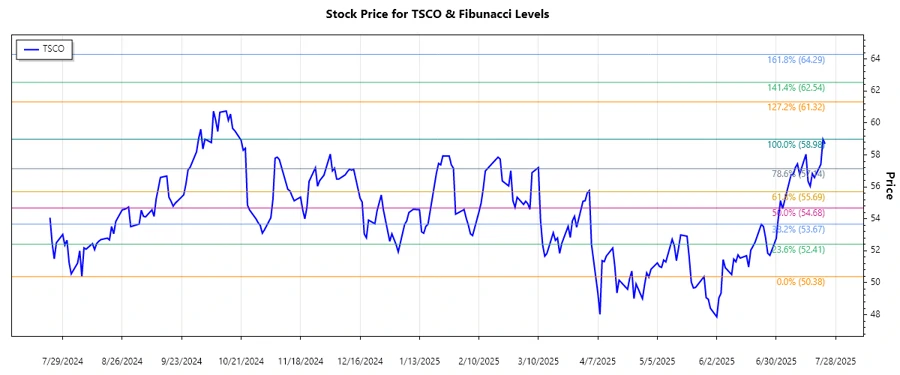July 23, 2025 a 04:44 pm


TSCO: Fibonacci Analysis - Tractor Supply Company

The Tractor Supply Company (TSCO) has shown resilience in its stock prices, with fluctuations reflective of market conditions and investor sentiment. Its diverse product offerings and extensive store network across the United States provide it with a significant market presence. Investors should consider both the agricultural sector's outlook and rural economic health when evaluating TSCO. Technical analysis indicates recent price recovery, suggesting continued bullish sentiment. Monitoring key support and resistance levels could be beneficial for potential investors.
Fibonacci Analysis
| Details | Information |
|---|---|
| Trend Start Date | 2025-05-27 |
| Trend End Date | 2025-07-23 |
| High Point (Price & Date) | $58.98 on 2025-07-22 |
| Low Point (Price & Date) | $50.38 on 2025-05-27 |
| Fibonacci Level 0.236 | $52.51 |
| Fibonacci Level 0.382 | $53.95 |
| Fibonacci Level 0.5 | $54.68 |
| Fibonacci Level 0.618 | $55.41 |
| Fibonacci Level 0.786 | $56.77 |
| Current Price | $58.7 |
| Retracement Zone | None (Above 0.786 Level) |
| Technical Interpretation | The current price is above the 0.786 Fibonacci level, indicating strong bullish momentum. This suggests potential support if prices pull back, with resistance and support expected around key Fibonacci levels above and below the current price. |

Conclusion
The analysis of Tractor Supply's stock indicates a prevailing upward trend with current prices exceeding significant Fibonacci levels, highlighting strong investor confidence. This suggests a positive price trajectory, yet investors should remain vigilant for potential corrections or market shifts. Risks include market volatility and economic factors affecting the rural and agricultural sectors. The identified Fibonacci levels suggest key support and resistance zones that analysts should monitor for future movements. Overall, Tractor Supply's stock demonstrates robust technical signals with favorable conditions for bullish strategies, balanced with awareness of potential risks.
